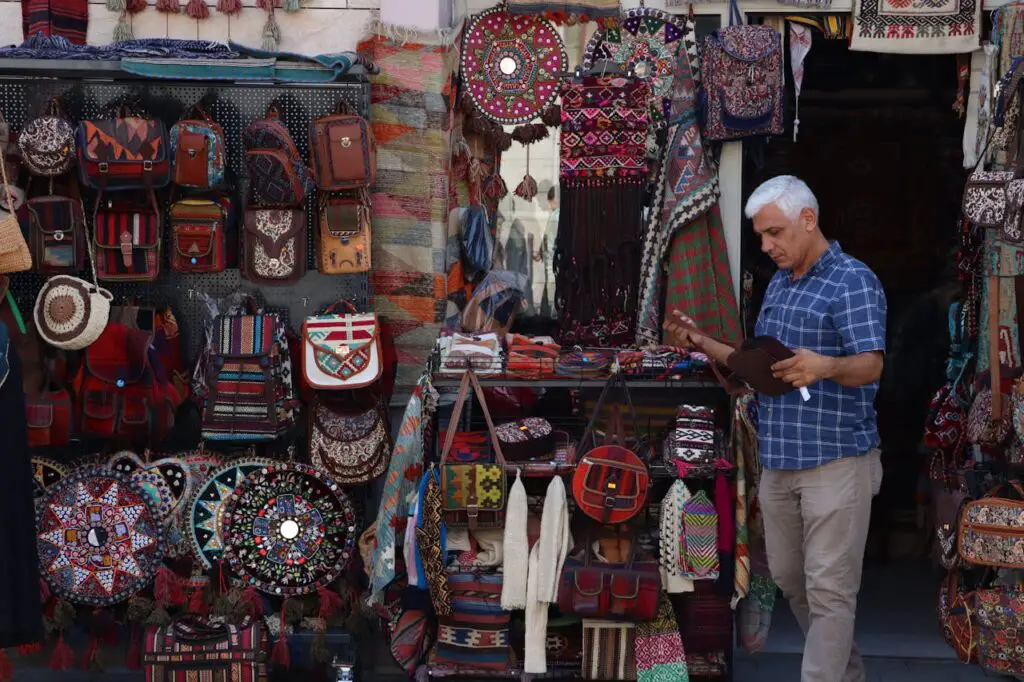Introduction: The Dance of Commerce
Shopping in Turkey is more than a transaction—it’s a cultural experience, a social ritual, and sometimes, a friendly duel of wits. The art of bargaining has been refined over centuries in Turkey’s bazaars and markets, creating a unique commercial culture that can be both exhilarating and bewildering for visitors. Understanding this dance of commerce—its rhythms, rules, and etiquette—will not only help you secure better prices but also deepen your appreciation for Turkish culture and create more meaningful interactions with local merchants.
This guide will walk you through what to expect when shopping in Turkey, from price ranges for common items to step-by-step bargaining techniques. You’ll learn when to negotiate, when to accept the stated price, and how to ensure that both you and the seller walk away satisfied. Whether you’re hunting for a handcrafted carpet in Istanbul’s Grand Bazaar or selecting spices in a neighborhood market, these insights will help you shop with confidence and cultural sensitivity.
Understanding Turkish Shopping Culture

The Social Aspect of Commerce
In Turkish culture, shopping is inherently social. The exchange of goods is intertwined with the exchange of pleasantries, stories, and hospitality. This explains why a carpet purchase might begin with tea and conversation, or why a shopkeeper might seem more interested in your home country than in making an immediate sale.
Cultural Insight: The Turkish word “pazarlık” (bargaining) shares linguistic roots with “pazar” (market), highlighting how central negotiation is to the traditional marketplace experience.
The Expectation of Bargaining
In certain contexts—particularly bazaars, markets, and small tourist shops—bargaining is not just permitted but expected. Sellers typically set their initial prices with the assumption that some negotiation will occur. Paying the first stated price in these settings is unusual and may even deprive the seller of the satisfaction of a properly concluded deal.
When Bargaining is Expected:
- Traditional bazaars and markets
- Small, independent tourist shops
- Street vendors
- Antique and carpet shops
When Prices Are Fixed:
- Department stores and shopping malls
- Supermarkets and chain stores
- Pharmacies
- High-end boutiques (though discounts may be offered for cash)
- Shops with clearly marked price tags
The Psychology of Turkish Bargaining
Understanding the psychological aspects of Turkish bargaining can help you navigate the process more effectively:
The Dramatic Element: Some sellers employ theatrical tactics—sighing deeply, looking pained, or claiming they’re selling at a loss. This is part of the performance of bargaining and shouldn’t be taken too literally.
The Relationship Factor: Establishing rapport can significantly affect your bargaining position. Sellers are often more flexible with customers they like or with whom they’ve built a connection.
The Walking Away Strategy: The moment when you genuinely decide to leave is often when the best price emerges. This isn’t just a tactic—it’s a crucial part of the bargaining dynamic that helps establish the true bottom line.
Price Ranges for Common Items
Understanding typical price ranges helps you gauge whether an initial asking price is reasonable or dramatically inflated. These ranges reflect 2025 prices and can vary based on quality, location, and your bargaining skills.
Souvenirs and Small Items
| Item | Tourist Area Price Range (TL) | Local Area Price Range (TL) | Bargaining Potential |
| Evil Eye Amulet (small) | 50-150 | 20-75 | Medium |
| Turkish Delight Box (250g) | 150-300 | 100-200 | Low-Medium |
| Ceramic Coffee Cup | 200-400 | 100-250 | Medium |
| Small Painted Tile | 200-500 | 150-300 | Medium |
| Cotton Peştemal (Turkish Towel) | 300-600 | 200-400 | Medium |
Mid-Range Items
| Item | Tourist Area Price Range (TL) | Local Area Price Range (TL) | Bargaining Potential |
| Leather Wallet | 500-1,000 | 300-700 | Medium-High |
| Small Mosaic Lamp | 800-2,000 | 600-1,500 | High |
| Silver Jewelry (simple piece) | 1,000-2,500 | 800-2,000 | Medium-High |
| Copper Coffee Set | 1,500-3,000 | 1,000-2,000 | High |
| Small Kilim (1×1.5m) | 3,000-7,000 | 2,000-5,000 | Very High |
High-Value Items
| Item | Price Range (TL) | Bargaining Potential |
| Leather Jacket | 5,000-15,000 | Very High |
| Gold Jewelry (per gram) | Current gold rate + 10-30% | Low-Medium |
| Medium Wool Carpet (2x3m) | 15,000-50,000 | Extremely High |
| Antique or Decorative Items | Highly variable | Very High |
| Silk Carpet | 50,000-500,000+ | Extremely High |
Currency Note: Prices are listed in Turkish Lira (TL). For high-value items, some sellers may quote prices in Euros or US Dollars, especially in tourist areas.
Regional Variations: Prices tend to be highest in Istanbul’s tourist areas and lowest in smaller towns and local markets. Coastal resort areas also command premium prices during high season.
For more detailed information about specific items to buy in Turkey, see our comprehensive “Turkey Shopping Guide: What to Buy and Where to Find the Best Deals”.
The Art of Bargaining: Step-by-Step Guide
1. Preparation: Do Your Research
Before entering serious negotiations, especially for higher-value items:
- Research typical prices for the item you’re interested in
- Visit multiple shops to compare quality and initial asking prices
- Decide your maximum price in advance and stick to it
- Carry cash (preferably smaller denominations) as it often yields better deals
Pro Tip: For items like carpets or leather goods, visit a museum shop with fixed prices first to understand quality benchmarks and reasonable price points.
2. Establishing Rapport: The Crucial First Step
The foundation of successful bargaining in Turkey is building a positive relationship with the seller:
- Accept offered hospitality like tea or coffee if you’re genuinely interested
- Exchange pleasantries and respond to personal questions (about your country, visit, etc.)
- Show genuine interest in the craftsmanship or history of items
- Compliment the shop or merchandise sincerely
Cultural Insight: Accepting tea doesn’t obligate you to purchase, but it does signal that you’re a serious potential customer rather than just browsing.
3. Opening the Negotiation: The First Offer
Once you’ve identified an item you’re interested in:
- Ask “How much is this?” (Turkish: “Bu ne kadar?”)
- Listen to the initial price without showing strong reaction
- Make a counteroffer at approximately 40-50% of the asking price for items with high bargaining potential
- Justify your lower offer based on quality, your budget, or prices you’ve seen elsewhere
Language Tip: Learning a few Turkish phrases can improve your bargaining position. “Çok pahalı” (chok pa-ha-luh) means “very expensive” and often elicits a smile and a better offer.
4. The Back-and-Forth: Finding Middle Ground
The heart of the bargaining process involves several rounds of offers and counteroffers:
- Move up in small increments from your initial offer
- Let the seller make larger downward moves from their initial price
- Maintain a friendly, good-humored tone throughout
- Use strategic silence after the seller makes an offer—this often leads to them lowering the price further
- Mention any defects or imperfections politely as justification for a lower price
Pro Tip: If buying multiple items, negotiate a package deal. Saying “If I take these three items, what’s your best price?” often yields better results than bargaining for each separately.
5. Closing the Deal: Finding the Sweet Spot
The final stage of bargaining requires recognizing when you’ve reached a fair price:
- The “final price” isn’t always final—sellers often have room for one more concession
- The walking away technique is powerful but should only be used if you’re genuinely willing to leave
- Look for the seller’s genuine bottom line—when their demeanor changes from theatrical to serious
- Close with grace and appreciation once you’ve agreed on a price
Cultural Insight: A successful bargaining session should end with both parties satisfied. The ideal outcome is a price that’s fair to both you and the seller—not one that leaves either party feeling exploited.
6. After the Purchase: Cementing the Relationship
How you conclude the transaction affects both your experience and the seller’s:
- Express genuine appreciation for the item and the seller’s fairness
- Don’t boast about getting a “steal”—this can sour the positive relationship you’ve built
- Consider taking the seller’s business card for future purchases or recommendations
- If truly satisfied, offer to leave a positive review or refer friends
Bargaining Etiquette: Do’s and Don’ts
Do’s
✅ Do bargain with good humor and patience Approaching negotiation as a friendly game rather than a confrontation creates a positive atmosphere.
✅ Do be prepared to walk away Your willingness to leave is your strongest bargaining tool, but only use it genuinely.
✅ Do buy if you agree on your target price If the seller meets the fair price you had in mind, make the purchase rather than pushing for even less.
✅ Do use cash for better deals Many sellers offer discounts for cash payments, which save them credit card processing fees.
✅ Do bargain harder for expensive items The higher the price, the more room for negotiation. A carpet might have a 50% margin, while a small souvenir might have just 15-20%.
Don’ts
❌ Don’t bargain if you have no intention to buy Starting negotiations when you’re just curious about the price wastes the seller’s time and energy.
❌ Don’t be aggressive or disrespectful Demanding tone or dismissive behavior will likely result in higher prices or refusal to negotiate.
❌ Don’t compare to “cheaper” shops unless you’re prepared to go there Claiming another shop offers a lower price may backfire if the seller simply encourages you to buy there instead.
❌ Don’t rush the process Bargaining in Turkey is rarely quick. Allow time for the social aspects and multiple rounds of offers.
❌ Don’t show too much enthusiasm for an item Revealing how much you love something weakens your bargaining position considerably.
Special Bargaining Scenarios
Carpet Shopping: The Ultimate Negotiation
Purchasing a Turkish carpet typically involves the most elaborate bargaining process:
The Experience: Expect to be invited to sit, served tea, and shown numerous carpets before serious price discussions begin. This process can take hours for a significant purchase.
The Strategy: Express interest in several pieces rather than fixating on one. Ask about materials, age, region, and technique to demonstrate knowledge. For high-quality carpets, expect to pay at least 30-50% of the initial asking price after negotiation.
Red Flags: Be wary of shops that rush you, don’t offer information about the carpets’ origins, or claim every piece is “antique” or “museum quality.”
For more detailed information about authentic Turkish carpets, see our “Authentic Turkish Souvenirs: The Complete Shopping Guide”.
Group Shopping Dynamics
Shopping with friends or family creates different bargaining dynamics:
The Challenge: Sellers may focus on the person they perceive as the decision-maker or the most interested party.
The Strategy: Decide roles in advance—perhaps one person acts more enthusiastic while another plays the budget-conscious skeptic. Avoid contradicting each other in front of the seller.
Pro Tip: Having a companion “pull you away” from a purchase can be an effective bargaining tactic, but use this sparingly and respectfully.
Shopping in Non-Tourist Areas
Venturing beyond tourist zones can yield better prices but requires different approaches:
The Challenge: Less English may be spoken, and bargaining might follow more traditional patterns.
The Strategy: Use simpler language, more gestures, and perhaps a calculator for suggesting prices. Respect may be more important than aggressive bargaining in local markets.
Cultural Insight: In neighborhood markets, building relationship through regular visits often leads to better prices than hard bargaining as a one-time customer.
Understanding Price Factors in Turkey
Seasonal Variations
Prices in Turkey fluctuate significantly based on tourist seasons:
High Season (June-August): Expect higher initial prices and less bargaining flexibility in tourist areas.
Shoulder Season (April-May, September-October): Often the best time for deals, as sellers are less busy but still have good cash flow.
Low Season (November-March): You might find desperate deals or surprisingly firm prices, as some sellers need to make up for fewer customers.
Location Impacts on Pricing
Where you shop dramatically affects pricing:
Tourist Hotspots: The Grand Bazaar in Istanbul, main streets in Sultanahmet, and central Cappadocia have the highest initial prices but often the widest selection.
Secondary Tourist Areas: Neighborhoods like Kadıköy in Istanbul or side streets in tourist towns often offer better value with moderate selection.
Local Markets: Weekly neighborhood markets (pazars) and shops in residential areas offer the best prices but may have fewer tourist-oriented items.
Quality Variations
Understanding quality differences helps justify price variations:
Materials: Natural materials (cotton, wool, silk, leather) command higher prices than synthetics. Hand-processed materials cost more than machine-processed ones.
Craftsmanship: Hand-made items with fine details justify higher prices than mass-produced alternatives.
Authenticity: Items made using traditional techniques by skilled artisans naturally cost more than factory-made reproductions.
For more information about identifying authentic, high-quality Turkish souvenirs, see our “Authentic Turkish Souvenirs: The Complete Shopping Guide“.
Tax Refund Considerations
As a tourist, you may be eligible for a VAT refund on purchases over a certain amount:
Eligibility: Non-Turkish residents can claim VAT refunds on purchases over 2,000 TL from shops displaying the “Tax Free Shopping” logo.
Process: Ask for a special invoice at the time of purchase, then present it at the airport tax refund office before departure.
Strategy: Factor potential tax refunds into your bargaining calculations for large purchases.
For a detailed explanation of the tax refund process, see our article on “Turkey Shopping Tax Refund Guide: How to Get Your VAT Back”.
Payment Methods and Currency Considerations
Cash vs. Credit
Your payment method can significantly affect the final price:
Cash Advantages: Many sellers offer 5-10% discounts for cash payments. Small shops and market vendors may accept only cash.
Credit Card Considerations: Major cards are widely accepted in established shops. Some sellers add a surcharge (typically 3-5%) for credit card payments.
Security Note: Carry only what you need for the day’s shopping. Use hotel safes for extra cash and valuables.
Currency Choices
Turkey’s currency situation offers strategic options:
Turkish Lira (TL): Best for most purchases, especially in local markets and smaller shops.
Euros/US Dollars: Sometimes accepted or even preferred for high-value items like carpets or jewelry, particularly in tourist areas.
Exchange Tips: Get the best rates at exchange offices (döviz) rather than hotels or airports. Check the current rate before shopping to calculate fair prices.
Regional Shopping Price Variations
Istanbul
As Turkey’s largest city and main tourist destination, Istanbul shows the widest price variations:
Highest Prices: Grand Bazaar main corridors, Sultanahmet shops near major attractions, Nişantaşı luxury district
Better Values: Grand Bazaar back alleys, Kadıköy market area (Asian side), Çukurcuma antique district
Local Insight: Prices in the Grand Bazaar can vary by 30-50% for identical items depending on the shop’s location within the bazaar.
Cappadocia
This popular tourist region has distinct pricing patterns:
Highest Prices: Göreme main street shops, cave shops in prime locations
Better Values: Avanos ceramic workshops, Ürgüp shops, village markets
Local Insight: Carpet prices in Cappadocia are often 20-30% lower than Istanbul for comparable quality, as overhead costs are lower.
Coastal Resort Areas
Turkey’s Mediterranean and Aegean resorts have their own pricing dynamics:
Highest Prices: Marina areas in Bodrum and Marmaris, main tourist streets in Antalya’s Kaleiçi
Better Values: Weekly markets, shops in residential neighborhoods, off-season visits
Local Insight: Prices in coastal areas can double during peak summer months compared to winter rates.
FAQs About Shopping and Bargaining in Turkey
Is bargaining considered rude in Turkey?
No, in appropriate contexts like bazaars and small shops, bargaining is a normal and expected part of the shopping experience. However, it should be conducted respectfully and good-naturedly. Bargaining is considered inappropriate in establishments with fixed prices like department stores and supermarkets.
How much should I expect to pay after bargaining?
For items with high bargaining potential (carpets, leather, handicrafts), you might pay 50-60% of the initial asking price after successful negotiation. For smaller souvenirs or items with low bargaining potential, 70-80% of the asking price is more realistic. Quality, location, and season all affect the final price.
What if I’m not comfortable with bargaining?
If bargaining makes you uncomfortable, you have several options: shop in fixed-price establishments like department stores; visit museum shops for authentic items at set prices; or simply ask the seller for their “best price” rather than engaging in extended negotiations.
Should I use Turkish lira or foreign currency when shopping?
Turkish lira is preferred and often required for most purchases. While some tourist shops accept euros or dollars for high-value items, you’ll generally get better deals paying in lira. Always check the exchange rate before shopping to calculate fair prices.
How can I tell if I’m getting a fair price?
Research typical price ranges before shopping, compare prices across multiple shops, and ask Turkish friends or hotel staff for advice on reasonable prices. Remember that “fair” means both you and the seller should be satisfied—extremely low prices may indicate poor quality or exploitation.
Conclusion: The Value Beyond the Price
Shopping in Turkey offers more than just the acquisition of goods—it provides a window into Turkish culture, an opportunity for meaningful human connection, and memories that will last far longer than the items themselves. The bargaining process, when approached with the right mindset, becomes less about saving money and more about participating in a cultural tradition that has connected buyers and sellers in Turkish marketplaces for centuries.
The most successful shopping experiences in Turkey occur when you value the interaction as much as the transaction. A carpet purchased after hours of conversation over apple tea, a piece of pottery bought directly from the artisan who created it, or a spice blend recommended by a shopkeeper who asked about your favorite Turkish dishes—these become souvenirs enriched with stories and human connections.
As you navigate Turkey’s vibrant markets and shops, remember that the true value of your purchases extends beyond the price you negotiate. The cultural insights gained, the relationships formed, and the deeper understanding of Turkish traditions and craftsmanship are priceless aspects of the shopping experience that can’t be quantified in lira, dollars, or euros.
For more information about where to shop in different Turkish cities, see our article on “Best Shopping Experiences in Turkey by City: Istanbul, Antalya, Cappadocia, and More”. If you’re interested in finding authentic souvenirs with cultural significance, our “Authentic Turkish Souvenirs: The Complete Shopping Guide“




